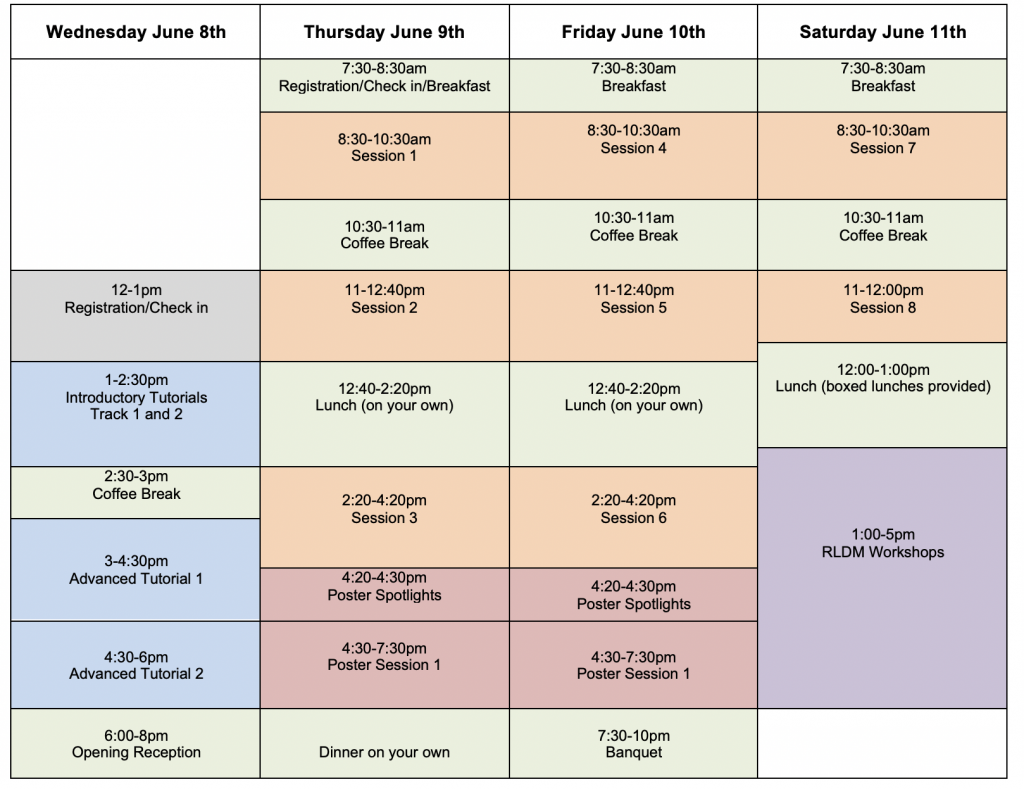RLDM 2022 Abstract Booklet (Final Version)
Videos of RLDM talks are now available online:
Split by day of meeting: Day 1 Day 2 Day 3 Day 4
Split by individual talk: link
Schedule at-a-glance:

Introductory Tutorial (Biological RL): Angela J. Langdon
Reinforcement learning in biological circuits: model-free value representations and beyond
Theories from reinforcement learning have been highly influential for interpreting neural activity in the biological circuits critical for animal and human learning. Central among these is the identification of phasic activity in dopamine neurons as a reward prediction error signal that drives learning in basal ganglia and prefrontal circuits. In this tutorial I will review the seminal results that led to the reward prediction error hypothesis of dopaminergic activity, with an emphasis on mapping biological features to the core computational ideas of RL and, in particular, the idea of model-free value learning. With this groundwork in place, I will introduce recent results that complicate the simple picture of dopamine as a scalar value prediction error signal and outline how model-based RL can make sense of the neural activity that underlies reward prediction and learning in the brain.
Introductory Tutorial (Computational RL): Amy Zhang
Basics of Computational Reinforcement Learning
Reinforcement learning focuses on the problem of using experience gained through interacting with the world and evaluative feedback to improve a system’s ability to make behavioral decisions. This tutorial will introduce the fundamental concepts and vocabulary that underlie this field of study. It will also review recent advances in the theory and practice of reinforcement learning, including developments in fundamental technical areas such as generalization, planning, exploration and empirical methodology.
Advanced Tutorial (Biological RL): Xiaosi Gu
Modeling The Social Brain
Given the complex and dynamic nature of our social relationships, the human brain needs to quickly learn and adapt to new social situations. The breakdown of any of these computations could lead to social deficits, as observed in many psychiatric disorders. In this tutorial, I will first introduce the theoretical framework underlying commonly used social neuroscience paradigms. I will then walk the audience through exampler computational models, including their setup and fitting procedures, that are used to probe social processes. Finally, I will demonstrate how modeling the social brain might help us better understand mental disorders. Taken together, this tutorial will aim to help the audience understand the dynamic and proactive nature of human interactions as well as the clinical significance of these higher-order cognitive processes.
Advanced Tutorial (Biological RL): Jacob Andreas
How to do things with words
Human language is one of our most powerful tools for communicating our beliefs, goals, and plans. Building automated agents that use language to interact with (and learn from) human users has been a major goal of artificial intelligence research since the earliest days of the field. This tutorial will survey modern techniques for incorporating language into sequential decision-making systems, with a special focus on approaches that use linguistic input as a source of background knowledge to guide exploration and generalization.
